How Easements Can Limit Potential Property Uses
By Jake Hubbell, ALC
I write this article after the conclusion of a fairly complex property purchase I had the pleasure of being involved in. The property in reference is 70 vacant acres on Missouri Heights in Carbondale, Colorado. A beautiful area north of Highway 82, with tremendous views of Mt. Sopris, and containing irrigated grass meadows rolling into hills with sage brush, oak brush, and pine trees. It sounds like a pretty easy land sale, right? Overall, this property had certain covenants it had to abide by, was not included within the adjacent HOA, but was somehow included in the maintenance cost for the road that the property does not use or benefit from in the HOA, had over 6 different water rights to examine (some of which could not even be delivered to the property), and the reason for writing this article, the high pressure natural gas line for Black Hills energy actually went directly through the eastern part of this property. (Picture attached).

Easements. In my working career, easements on ranches and land properties typically refer to a neighboring owner with an access easement, a utility company with a utility line and easement to maintain such line, or public road right of way through or along properties to access BLM lands through private property. In this case, Black Hills energy had a previous 4″ high pressure natural gas line running through this property. This gas line feeds the towns of Aspen, Basalt, Willits, and Carbondale for natural gas, and with the development of the valley in the past 30 years, the 4″ line needed to be expanded and upgraded to a 6″ line. In this circumstance, there was the pre-existing easement for the utility that passed through the property, with a 50 foot right of way, 25 feet to either side from the center of the gas line.
It may not seem like a large impediment, but the 50 foot wide strip of land that traverses through the property takes up more space than you’d anticipate, and limits use on the property. The property owner may not build any improvements or construct any ponds, or plant trees, or really do anything within that right of way but maintain the earth on top of it and hopefully grow grass for hay in the future.
Here’s where it got complex. The property owner also owned the tract across the road to the east, and his negotiation to allow the upgrading of the pipe and staging that work on his land was that his property, along with the subject property, would received natural gas taps. To deliver this natural gas tap to his neighboring property to the east, a new tap location and small 2″ line had to be bored through the earth to his building location. And with that, the location of the line required a new easement to be put in place, now crossing through the property perpendicular to the adjacent 30 foot wide existing utility easement.

What’s the big deal? Well, now with the other utility line running to the east, and having a 15 foot wide easement, it was now encumbering more of the property, and limiting any future use of that area of land. Effectively rendering the SouthEast portion of the property useless for anything besides a parking lot in the future.
You can see in the photo all the arrows drawn on the map. Each of these arrows indicates the distance that each utility easement reaches from the centerline going outward. So examining the photo, you can see the large pipeline running North-South, an existing easement in a backwards “L” shape in the bottom right of the property, and the new easement in a red “L” above it. Looking at where the Yellow arrows are, does it look like there’s any room in that corner of the property where a building or pond or structure could be located?
Effectively, 5-6 acres of land on this parcel was now encumbered by easements where the property owner could not build a shop or pond anywhere in this location, and when locating his main home would have to push the building site further out to the West, and pay to have utilities moved longer distances.

Summary: When purchasing land, it’s important to have a qualified land broker to assist you in researching the title work, identifying what any easements mean, locating the easements on the property, and potentially having a surveyor provide a Improvement Location Certificate to identify where any easements are. You can’t build a house, shop, or any structure over a utility easement, so it’s important to know how your use of the property could be limited.
Jake Hubbell, Accredited Land Consultant

